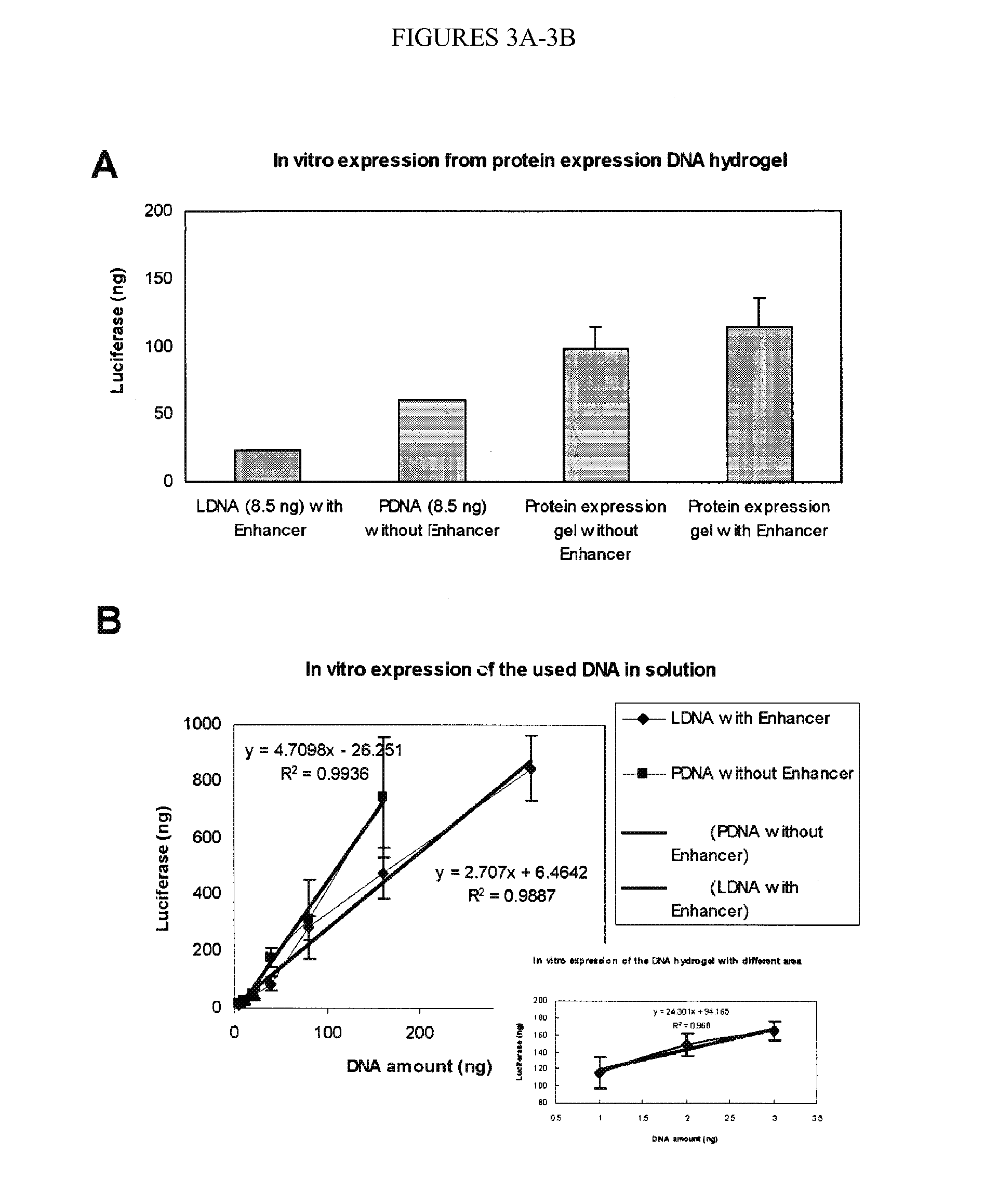Nucleic acid-based matrixes
a polymer structure and nucleic acid technology, applied in the field of nucleic acid-based polymer structures, can solve the problems of limiting the utility of dna-based materials, less stable rna than, and still problematic design and production of dna-based materials
- Summary
- Abstract
- Description
- Claims
- Application Information
AI Technical Summary
Benefits of technology
Problems solved by technology
Method used
Image
Examples
example 1
X-DNA Gel
[0382]In one aspect of the invention, the branched nucleic acids are designed comprising sequences depicted in Table 3. Without further purification, oligonucleotides (Integrated DNA technologies) were dissolved in an annealing buffer (10 mM Tris, pH=8.0, 1 mM ethylenediaminetetraacetic acid (EDTA), and 50 mM NaCl) with a final concentration of 50 mM. X-DNA was constructed by mixing four oligonucleotide components (with the same molar ratio) in sterile Milli-Q water with a final concentration of 20 mM for each oligonucleotide. Hybridizations were performed according to the following procedures: (i) Denaturation at 95° C. for 2 min. (ii) Cooling at 65° C. and incubation for 2 min. (iii) Annealing at 60° C. for 5 min. and (iv) Further annealing at 60° C. for 0.5 min with a continuous temperature decrease at a rate of 1° C. per min. The annealing steps were repeated a total of 40 times. The final annealed products were stored at 4° C. The X01 to X04 were four corresponding sin...
example 2
[0399]Nucleic acid hydrogels were explored for use as a novel, long-term, controlled drug release system (FIG. 3B). Two different model drugs were encapsulated and tested: (S)-(+)-camptothecin (CPT) and porcine insulin. CPT is a small molecule drug (Mw=348.3 Da) with anti-leukemia and anti-tumor activities while insulin is a macromolecule protein drug (Mw=5777.6 Da) with glucose regulation functions. Encapsulation was achieved in situ (no post-gelation loading was needed) and encapsulation efficiencies were extremely high (close to 100%). For the CPT drug, 99.6%, 99.5% and 99.5% efficiencies were obtained using X-, Y-, and T-DNA gels, respectively. For the insulin drug, 90.1%, 95.7%, and 96.6% efficiencies were achieved with X-, Y-, and T-DNA gels, respectively. Furthermore, FIG. 3B shows the controlled release profiles of these two drugs from 0.2 mM DNA hydrogels in PBS at 37° C.
[0400]No burst release was detected, and relatively smooth release curves were obtain...
example 3
Cell-Free Protein Production
[0405]A new DNA hydrogel was constructed utilizing nucleic acids, where linearized plasmid vector containing a gene for renilla luciferase was used to cross-link X-shaped DNA (X-DNA), incorporating the gene into the DNA hydrogel. Renilla luciferase is a 36 kDa monomeric protein and does not require a post-translational modification for activity. The linearized plasmid vectors were prepared by digesting the vector at a single site using Mlu I restriction enzyme. The X-DNA building blocks were prepared through complimentary hybridization of four different oligonucleotides. The gel electrophoresis result showed a complete linearization of the circular DNA after Mlu I digestion (FIG. 1A). In addition, the complete X-DNA building blocks showed retarded mobility in 3% agarose gel (FIG. 1B): The faint bands below the complete X-DNA building block correspond to incompletely formed X-DNA.
[0406]The cross-linking (e.g., ligation) of X-DNA to linearized plasmids was ...
PUM
| Property | Measurement | Unit |
|---|---|---|
| elongation | aaaaa | aaaaa |
| molecular weight | aaaaa | aaaaa |
| size | aaaaa | aaaaa |
Abstract
Description
Claims
Application Information
 Login to View More
Login to View More - R&D
- Intellectual Property
- Life Sciences
- Materials
- Tech Scout
- Unparalleled Data Quality
- Higher Quality Content
- 60% Fewer Hallucinations
Browse by: Latest US Patents, China's latest patents, Technical Efficacy Thesaurus, Application Domain, Technology Topic, Popular Technical Reports.
© 2025 PatSnap. All rights reserved.Legal|Privacy policy|Modern Slavery Act Transparency Statement|Sitemap|About US| Contact US: help@patsnap.com



